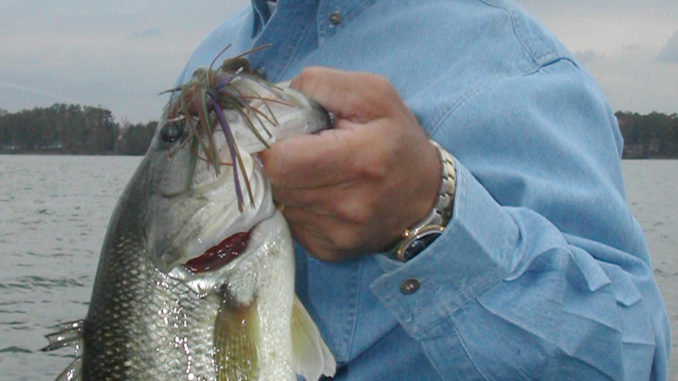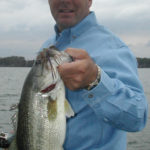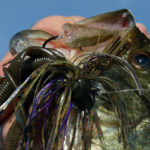
In South Carolina, nothing can beat February
If you have read my column for a few years, you know what’s coming in February. I’d like to talk about something else this month, but I just can’t. In South Carolina, February is by far my favorite month to go out and catch a big bass.
We’re blessed in this state to usually have some beautiful days in February, some days when the temperature gets up in the 60s, maybe even toward 70, and that’s when you find the big females that are coming up and staging.
I’ve seen some fish spawning in February, but typically, the spawn around here is in March and April. Those big females know it’s not time to spawn, but they know it’s right around the corner, and they’re getting ready. I’ve caught more big fish in February and early March than any other time of the year; it’s that good.
When I get started, I look for places where it’s easy for fish to move up in relatively shallow water out of relatively deep water: points, the outside bends of creek channels, places like that. I like to concentrate on the first point inside the mouth of a creek or a little finger off the main lake or main river. I like to have my boat sitting in eight to 10 feet of water, throwing to the bank, but it’s relative. At Santee Cooper, you might be in five or six feet of water, but at Hartwell, Murray or Clarks Hill, you’re probably out a little deeper. In March or April, you’ll be in two or three feet of water, throwing to the bank, but in February, fish like those places where they can move up vertically without having to move a long ways horizontally. You don’t want to be fishing flatter banks.
A key is knowing what the surface temperature is. Here in South Carolina, we’ve typically got water temperatures between 50 and 55 degrees in February. It can be colder, and it can be warmer, but that’s a good average, and that’s the time when bass start to rise. The key is to get out when the water temperature is rising, because the fish will get really active. If you’ve got 52 degrees of water, and the temperature is stable, they may not be doing anything, but if you’ve had 52 degrees, and you’ve had a day or two of warm weather and the temperature is moving up to 55, those are the days to go.
The bass know that the days are getting longer, they’re know they need to feed, and when they feel that water start to warm, they’ll move right up there. It can be awesome. I’m one of those people who believe that the biggest fish move up first; I truly believe that it does work that way, so I make sure that when we get our first good warming trend in February, I want to be out there.
A few other things. I think it’s more important to be in the right kind of place, where fish can move up real quick, than it is to be in a place with good cover. Those fish being able to move up several feet; that’s where I want to be fishing, whether it’s got good cover or not. Second, when the water temperature gets into the upper 50s, I’m not as scared of stained or dingy water as I am when it’s about 45 to 50. I grew up fishing Lake Murray, and I spent most of my time on the upper end of the lake, where the water is more stained or dingy. I know when the water temperature is in the 50s and rising, those fish will get aggressive, no matter what the water looks like. And last, if I have a choice of a window of a couple of hours to fish, it will be either at first light or in the afternoon. For everything in nature, first light is important; those fish will move up at first light and be active and feed, but in February, if you can fish a couple of hours in the afternoon, when the sun has had a chance to warm the water a few degrees, that can be great.
Now, it’s time to catch a big female. My favorite big-fish bait of all time is a half-ounce Buckeye mop jig. It imitates a crawfish, and this time of year, the crawfish are out and about, and the fish really like them. Bass treat crawfish the way deer treat white oak acorns; if they’re around, they’ve got to eat them. I fish a brown jig with a soft-plastic trailer, a Trigger-X Flappin’ Craw. I like to fish a brown, orange or red trailer; Trigger-X has a color I really like called “Muck.” It’s sort of a green/orange, and it really looks good with that brown jig. In February, I also like to fish a jig with a rattle; mop jigs have a little collar that you can slip a rattle under, and I’ll always fish one this time of year.
I’m really casting the jig, not flipping it, so I’m fishing it on a 7-foot, medium-heavy All-Star rod with a Pfleuger Patriarch baitcasting reel spooled with 15- to 20-pound Trilene 100 Percent Fluorocarbon. It depends on what color the water is; that 15-pound line is strong enough to catch any bass that’s swimming in South Carolina, but if the water’s dingy and I can get away with 20-pound, I’ll fish it.
With a living rubber skirt, you can get a lot of motion or action out of a jig without moving it a lot. How you fish it depends on the temperature. If it’s warming, fish it faster.
I can’t tell you how much I love to fish for big bass in February; I hope you find out for yourself this month.






Be the first to comment